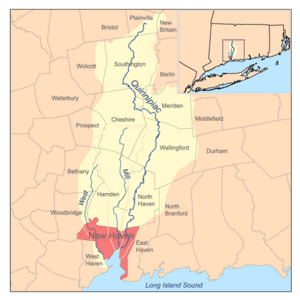West River (Connecticut) facts for kids
The West River is a freshwater stream in southern Connecticut. It is about 13.5 miles (21.7 km) long. The river flows through the towns of Bethany, Woodbridge, and New Haven. Finally, it empties into New Haven Harbor.
In New Haven, the river flows past Edgewood Park and the West River Memorial Park. The river's natural path winds along the western side of West River Memorial Park. There is also a very straight channel that cuts through the middle of the park. This straight channel was once used for rowing. You can find a public canoe launch in this channel near Derby Avenue. The City of New Haven Department of Parks, Recreation, and Trees takes care of it.
Contents
What Are Dams and Why Are They on the West River?
The West River has several dams built across it. Dams are barriers that stop or slow the flow of water. Some of the lakes created by these dams hold water for people to drink. The South Central Connecticut Regional Water Authority uses these reservoirs. The reservoirs are called Konolds Pond, Lake Dawson, Lake Watrous, and Lake Bethany. They are listed from south to north.
A Look at the West River's Rowing Course History
A special rowing course was built along the West River in New Haven in 1920. This area is now West River Memorial Park. At that time, Yale University thought about making a bigger course. They wanted to use it for college rowing races. But they decided not to build it.
Later, in the mid-1970s, there were more plans. People wanted to make the rowing course even bigger. They hoped to turn it into an "Olympic rowing course." This project would have included a grandstand for 5,000 people. It would also have had other sports facilities. However, these big plans never happened.
How Tide Gates Changed the River Environment
Around 1920, the City of New Haven put in special gates called flapper tide gates. These gates were placed downstream of Orange Avenue. The city installed them for a few reasons. They wanted to control mosquitos and prevent floods. They also wanted to fill in some saltwater marsh areas. This would create more land for building.
However, these gates caused problems for the river's environment.
- They stopped fish from swimming upstream to their old spawning areas. Spawning areas are where fish lay their eggs.
- They changed the plants in the area. The water became fresh instead of salty.
- They limited how much fresh water could flow through the river.
- They reduced the ocean's tidal influence. This affected areas like the Duck Pond in Edgewood Park.
Because the water became fresh, plants that don't belong there started to grow. These are called invasive species. One common invasive plant is the common reed (Phragmites australis). Its strong roots and thick growth pushed out many native plants.
Restoring the West River: A Community Effort
People knew the river was in trouble for many years. Yale University and consultants hired by New Haven studied the problem. In 2009, a project began to help the river. It was called the West River Habitat Restoration Project. This project received money from the American Recovery and Reinvestment Act. The money was given out by NOAA. A local environmental group, Connecticut Fund for the Environment, managed the project.
The plans for the project changed a few times. This was because people in the neighborhood gave their ideas. The project finished in 2012. Workers removed 3 of the 12 old flapper tide gates. They put in 3 new gates called self-regulating tide gates (SRT).
These new SRTs work differently. They let water leave the river when the river level is higher than the harbor tide. They also let saltwater from the ocean enter the river when the tide rises. The SRTs can also close if the incoming tide is very high. This prevents damage to things built upstream.
It will take many years for the river to return to how it was before 1920. But some good changes have already happened. The invasive Phragmites plants are showing signs of stress. Many acres of tidal wetlands have been restored. Also, people have seen more fish swimming upstream.



